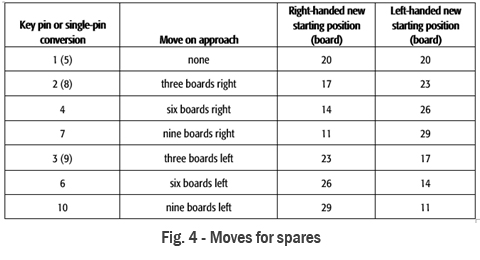Fundamental
Mental focus: Take a deep breath to relax
Diaphragmatic breathing helps you stay physically relaxed and helps the mind focus.
Before your shot take a deep breath in through your nose and exhale through your mouth. Some people prefer to do this before stepping on the approach while others do this as they're getting into the stance position.
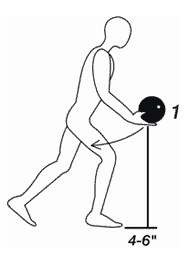
Keep the first step short
A short first step in your approach will allow you to maintain good balance. Each successive step will be slightly longer to build momentum to the finish position.
In a four-step approach, your ball-side foot steps forward as your arm with the ball moves out in a rounded motion. At the end of the first step, the ball should be about 4 to 6 inches in front of the ball-side foot ready to fall into the back swing. In a five-step approach, your short first step is with your non-ball-side foot. Your second step with your ball-side foot then imitates the four-step approach example above.
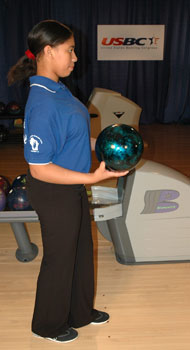 Starting a relaxed swing
Starting a relaxed swing
Using too much muscle will pull your swing off line and make it difficult to be consistent. In addition, using muscle causes your swing to feel restricted, which actually slows it down.
A relaxed swing starts in the stance by keeping your grip relaxed. To develop this feel, try this drill from the USBC Athlete Development Drills package.
- Get into a comfortable stance position holding the ball about waist high. Move your ball-side foot back more than usual to have additional balance.
- Squeeze the ball as hard as possible and hold it for seven to ten seconds. You should feel the tension in your hand, arm and shoulder.
- Relax your grip and feel the difference
When ready to bowl, make sure your arm and hand are relaxed before you start your approach.
 Aim your push away at your lane target
Aim your push away at your lane target
As you start the ball moving in your approach, make sure that the ball moves in a straight line toward your target on the lane. This will help prevent your swing from going off line. Let the rest of your swing be relaxed and keep it in a straight line toward your target.
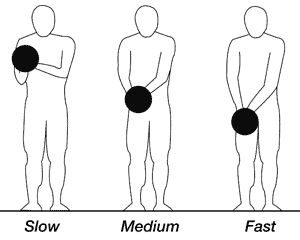 Ball Height in the Stance
Ball Height in the Stance
The height of the ball in the stance is used to match the arm swing to the tempo of your steps. You may have heard coaches use the phrases "slow down" or "speed up" your feet during the approach. USBC Coaching recommends that you adjust your swing to match your natural tempo.
If you have a fast tempo, you do not have the time for a long swing. Hold the ball low (between your thigh and waist) to shorten the time of the swing to match. If you have a slow tempo, hold the ball above your waist to lengthen the time the ball swings. Most people end up holding the ball about waist high.
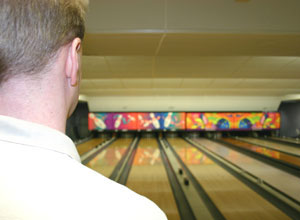 The line in your mind
The line in your mind
In bowling, visualization and positive imagery are powerful mental game techniques. These concepts program the mind and set the tone for your next delivery. This technique is called the "line in your mind."
Imagine your ball path as a line drawn on the lane surface. In your stance, visualize a line beginning at the foul line (your release point) extending through your target on the lane and then into the pocket. Picture that line, relax and roll the ball down that path. To make this stand out in your mind, make that line your favorite color.
Getting lined up
Getting lined up and staying lined up are two different tasks. Getting lined up refers to finding the initial combination of starting position, target, release and ball selection to maximize your scoring potential. Staying lined up refers to adjustments you can make as lane conditions change during a session.
Getting lined up can be a challenging process. Each session, no matter how routine, must be approached with an open mind and a curiosity about the lane condition. Do not limit yourself by determining where you are going to stand and aim, then use equipment to "fine tune." Sometimes the best option is to play a different part of the lane than you normally use.
Begin practice by rolling your favorite ball on your favorite part of the lane. Watch the ball reaction carefully to see where it begins to curve and how much. Using this "benchmark" will help you determine what changes, if any, are needed. Also watch where other people are playing with success. Is it an inside or outside line? Especially watch people using a similar style to your own.
If the lanes are oily, plan to use a straighter line to the pocket. Trying to force the ball to curve more will lead to accuracy problems. If the lanes are hooking, you may need to use a softer release or less aggressive equipment. Sometimes moving to a different part of the lane will help you find the amount of oil that will be a better match to the ball selection and release you prefer. Generally the outside of the lane will be drier and the inside will have more oil.
The Golden Rule of bowling: Move in the direction of the miss
Making adjustments is part of bowling. Knowing this and being prepared to make changes often will give you an edge on the competition.
The bowlers Golden Rule is to move in the direction of the miss, while keeping the same target on the lane. The concept of this adjustment is based on the use of a pivot, with the pivot being the target on the lane. If the ball misses to the left of the intended pin(s), move left on the approach. If the ball misses to the right of the intended pin(s), move right on the approach.
Bowlers often will need to make this adjustment several times during a match. To do so, a bowler must be aware of his or her starting point on the approach and how the ball was released.
.jpg)
Find your starting position and target
It takes time to learn how your starting position on the approach and the location of your target on the lane affects how your ball will hit the pins. You may feel like you and your ball are all over the place, but once you determine the proper combination of foot placement and ball targets, your game will greatly improve.
First, determine where you should stand on the approach to begin your delivery (see Fig. 1). Place your heels on the foul line, facing away from the pins. If you have a four-step approach, take four-and-one-half brisk walking steps and turn around. This is your starting position. If you use a five-step approach, add one step to find your staring position.
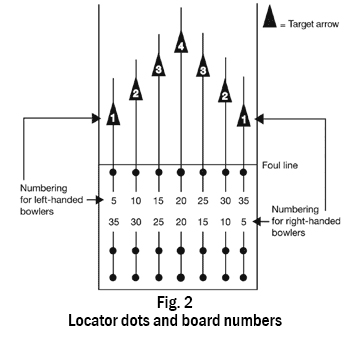
Use the dots on the approach to help you position your feet in the correct place from right to left and the arrows on the lanes as targets at which to aim (see Fig. 2).
For most beginning bowlers, USBC Coaching recommends standing on board No. 20 in the middle of the approach. Right-handers should line up on that board using the inside of the left shoe and left-handers the inside edge of the right shoe.
Use the second arrow from the channel as your target. This arrow gives your ball a good angle into the pocket at the pins and provides some margin of error to the right and left of the channel.
Keep the ball out of the channel
To keep your ball on the lanes and away from the channels, you need to know two things to make adjustments: 1) exactly where you stood on the approach and 2) your target on the lane.
USBC Coaching recommends the second arrow for most bowlers. Remember that the arrows are counted from the channel in (right-side channel if you are right-handed, left-side channel if you are left-handed). The arrow in the middle of the lane is the fourth arrow.
To avoid throwing into the channel, keep your shoulder straight during the stance, approach and delivery. Start your stance with the ball at a comfortable height in front of the ball-side shoulder and not in front of your body. A person standing directly behind your shoulder should see just a bit of the ball. Your forearm should point like an arrow to your target.
As you take your approach, keep your shoulder steady and be careful to not let it turn or move forward or backward. Imagine you are keeping your ball in a track during your swing.
Make a mental checklist for the approach
It's natural to get nervous while bowling especially during league and tournament competition. Unfortunately, being nervous can cause your muscles to tighten, making it difficult to bowl well. Your bowling will be better if both your muscles and mind are relaxed.
Try this trick to get a grip on nerves: As you settle into your stance on the approach, concentrate on a mental checklist of all the components of your approach and delivery. This will help you focus on what you need to do to get the scores rather than on the score itself.
Your checklist can include the following:
- Position your feet on the proper boards for the shot.
- Visualize and then get into the correct stance.
- Choose and focus on a lane target.
- Take a deep breath, exhale and roll the ball through your target.
Get new shoes to slide
Slide soles on bowling shoes do not come ready to slide from the factory. They must be broken in either by use or other preparation.
Using a soft wire brush, lightly brush the shoe from the toes back in the direction of the slide. Brushing side to side will make the sole rough and not smooth for sliding and brushing too firmly will destroy the slide sole altogether. If you do not have a wire brush, rub the sole against the edge of a door or wall.
If you use powder, use one that is specifically designed to make the sole slide. Powder hand conditioners or rosins can have the opposite effect. Use powder sparingly and knock off any loose powder before bowling as it can cause a hazard for other bowlers who may step in it. Powder on the approach is also technically illegal as it is considered defacing the approach.
Checklist for the new season
Before the beginning of league play, make sure to check to see that your equipment is still up to par. Keep these things in mind as you do:
- Check your grip. Our hands sometimes change enough that we must adjust the fit of the bowling ball. If you have to worry about getting your hand in the ball or holding onto it, you cannot bowl your best.
- Replace your finger inserts. If you use inserts, get them changed. They wear out and get brittle over time.
- Clean the ball with rubbing alcohol or a cleaner designed for bowling balls. If you polish your ball, this is a good time for that, as well.
- Get your ball resurfaced. If your ball is scratched or dinged up, a resurfacing will make the ball perform a bit better and it will look much better sitting on the ball return.
- Don't forget your towel. If you adhere to the superstition of not washing your bowling towel during the season, then wash it now! Hand wash your towel with a dish washing detergent that fights grease, then throw the towel in with the rest of your laundry.
- Check the soles and insides of your shoes.
- And one more thing: Do yourself a favor and practice a few games before the season. Your teammates will appreciate it!
Hit the mark with a straight arm swing
The most common cause of a poor shot is a poor arm swing. You should have a straight swing that stays in line with the target on the lane throughout your delivery.
In the starting stance, position the ball to your side-not in front of your body. Part of the ball should be visible to someone standing behind your shoulder.
On the forward swing, your forearm should point to your target like an arrow. As the ball is pushed out, the ball should be in a groove or track that is in line with your body and target. Pushing the ball away from or pulling it in toward your body can cause the ball to swing in the opposite direction and off the target.
Handshake position key to throwing a curve
The easiest way to learn to roll a hook is to set your hand in a handshake position. Right-handers should turn their bowling hand slightly so that the thumb points toward the 11 o'clock position on a clock face. A left-hander should turn his or her bowling hand so that the thumb points toward the 1 o'clock position.
The hand should remain in this position through the entire approach and release. In the finish position, it will look like you are shaking hands with your target.
Because the thumb will release first, the fingers will put a bit of side rotation on the ball and make it curve.
Improve with a positive mental attitude
Having a positive mental attitude is the first step toward bowling well, especially at a center where you haven't fared well in the past. You should never think, I don't bowl well at this center, because that can turn into a self-fulfilling prophecy: You think you will bowl poorly and you will bowl poorly.
Instead of dwelling on past experiences, call to mind all the skills and techniques it will take to bowl well this time, then use them. You'll be surprised at the results of having a positive mental attitude and it will probably rub off on your teammates or doubles partner, too.

Use the key pin to make spares
A good spare shooter must have a plan before each shot. The3-6-9 system is great for those who roll the ball straight or with a slight curve. The bowler moves left or right on the lane depending on which pins are still standing after the first ball. The target on the lane usually stays the same as for the strike ball and the ball is rolled across the lane at the spare.
For this system to work, you must know which board you stood on for the strike shot (see Fig. 2) and be able to identify and hit the key pin (see Fig. 3) which can be the only standing pin or a cluster of pins which is usually the lowest pin number or the pin closest to you.
After identifying the key pin, the bowler will move three boards in the opposite direction for each column that the key pin is away from the head pin. For example, the 2-and 8-pins are one column to the left away from the head pin. If either of those pins is standing after the first ball, move your feet three boards to the right and roll the ball across the lane. If the 10-pin is left standing that would be three columns to the right so the bowler moves their feet nine boards to the left and rolls the ball across the lane. For all moves (see Fig. 4).
